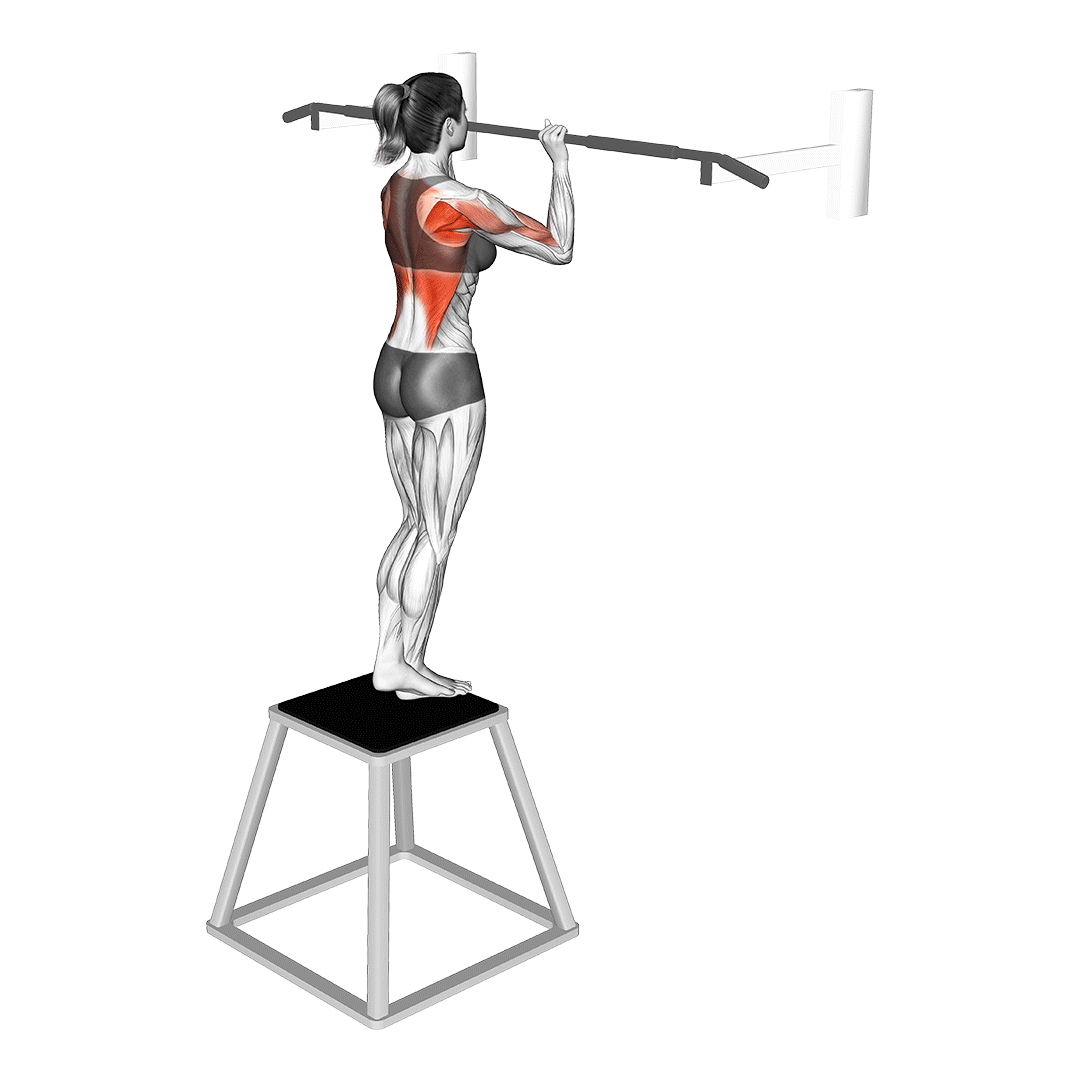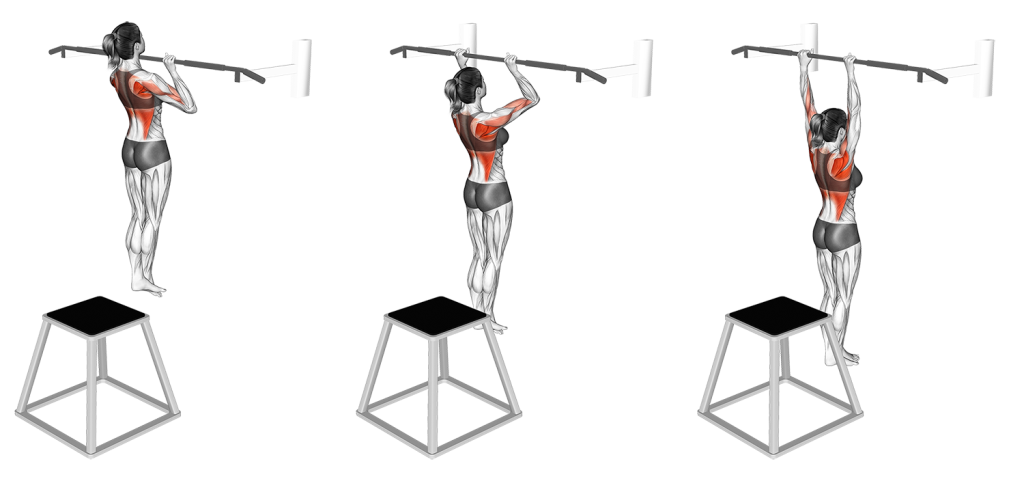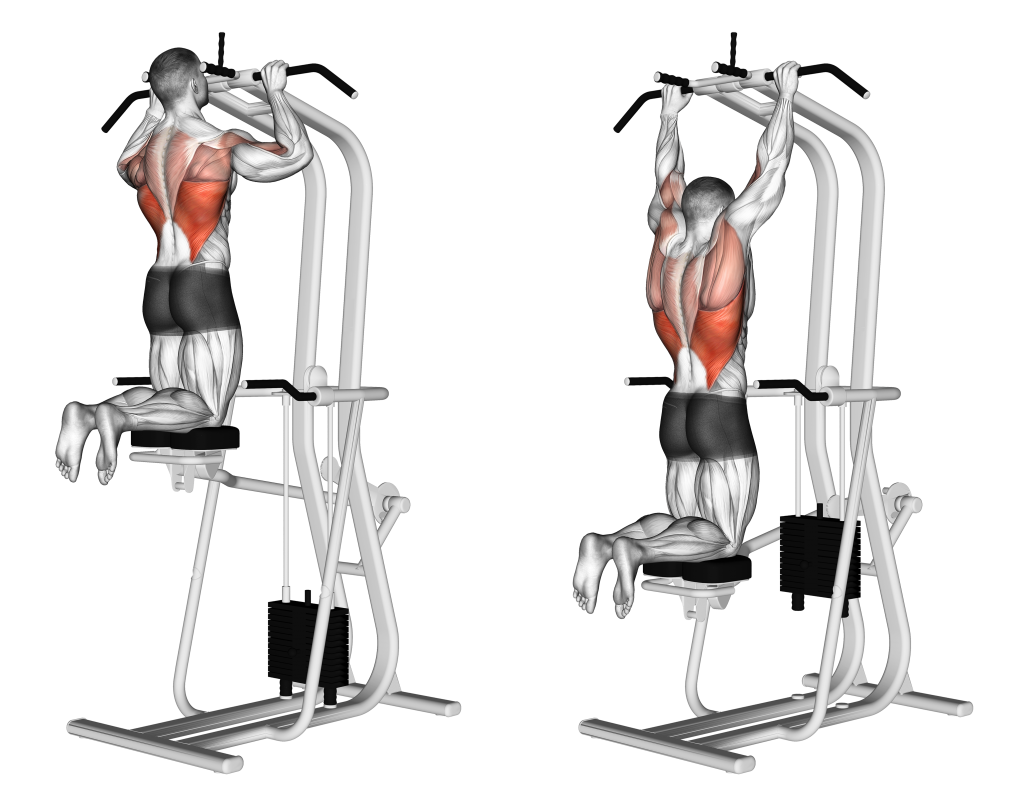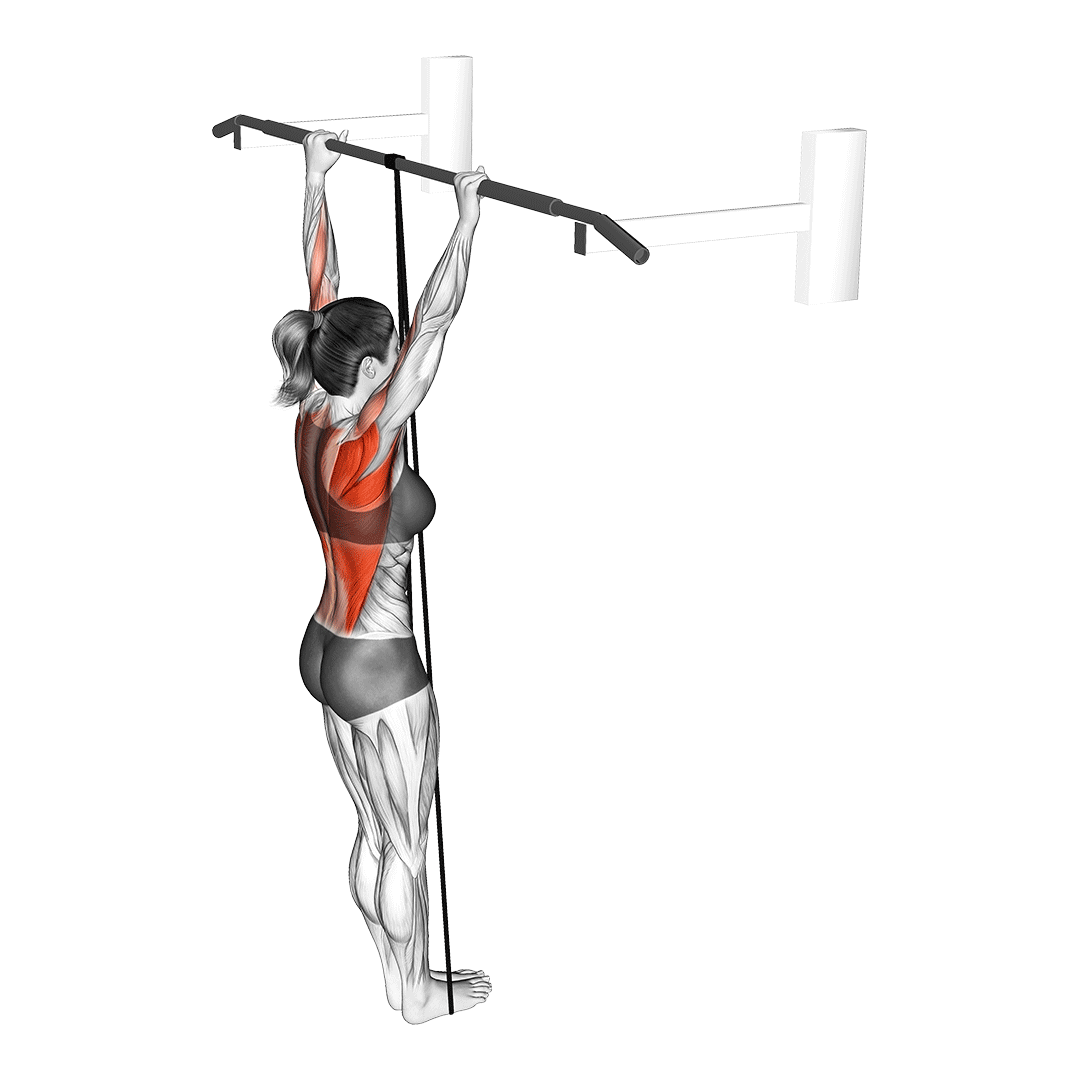Negative/Eccentric Pull Ups: The Purpose Explained
Whether you’re a novice just getting into pull-ups or a calisthenic athlete wishing to optimize their technique, the eccentric pull-up is an invaluable tool.
Eccentric or “negative” pull-ups are simply conventional pull-ups performed with the descending half of the exercise slowed down - leading to a lengthier time under tension and greater isometric recruitment.
Negative pull-ups are highly effective at building up upper back strength and endurance, but are most often employed as a progression to full pull-ups instead. To learn how best to take advantage of this invaluable pull-up variation, read on.
What are Negative Pull-Ups?
In more technical terms, negative pull-ups are a multi-joint compound exercise involving the exerciser’s own body as a source of resistance.
hey are considered to be a calisthenic exercise of novice difficulty, and are often performed as the main compound movement in back workouts.

While negative pull-ups are most often used to help individuals who cannot yet perform conventional pull-ups to significant volume, they are also excellent as a supplementary exercise when paired with conventional pull-ups or barbell rows.
Who Should Do Negative Pull-Ups?
Negative pull-ups are accessible and novice-friendly, meaning that anyone can do negative pull-ups.
However, individuals with a history of shoulder blade or shoulder weakness may wish to first consult a physician before performing negative pull-ups.
How to do Negative Pull-Ups
To perform a repetition of negative pull-ups, the exerciser should begin with a dead hang stance, the pull-up bar held in a pronated grip overhead.
Then, bending at the elbows and contracting the core musculature, the exerciser will raise themselves upwards until their head is higher than the pull-up bar.
Exercisers who cannot perform this initial half of the negative pull-up can skip it entirely and instead begin the exercise from the top position - either by jumping from the ground or by using a stool to elevate them higher.
From this position, the exerciser will arrest their momentum and pause, before descending as slowly as possible back to the original dead hang position.
The descent can last for anywhere between 3-5 seconds, and the repetition is considered complete once the arms are fully extended overhead.
What Muscles are Worked by Negative Pull-Ups?
Negative pull-ups are a compound exercise, and as such train more than a single muscle group at the same time.

Muscles worked to a highly intense and dynamic capacity are called primary mover muscles, with other muscles worked in a lesser manner being called secondary mover muscles.
Muscles recruited solely in an isometric capacity are called stabilizer muscles.
Primary Mover Muscles
Negative pull-ups primarily target the latissimus dorsi, trapezius, rhomboids, teres major and the biceps brachii.
Secondary Mover and Stabilizer Muscles
Other muscles recruited by negative pull-ups are the posterior deltoid head, brachialis, the core muscles and the erector spinae.
What are the Benefits of Negative Pull-Ups?
Not counting the sort of benefits derived from any resistance exercise, negative pull-ups also offer a host of further benefits that are solely derived from the exercise itself.
Superior for Strength and Endurance Development
Muscular strength and endurance are better developed from a long time under tension - of which is a defining aspect of the negative pull-up.
In particular, the negative pull-up will strengthen not only the muscles of the back, but many of the secondary and stabilizer muscles that are also used in conventional pull-up repetitions.
Lifters seeking greater strength in their upper back and arms will find that the lengthy repetitions of the negative pull-up may build better strength and endurance than is seen with conventional pull-up repetitions.
Helps Reinforce Proper Pull-Up Technique
Negative pull-ups are among one of the best ways of training to be able to do full pull-ups.
Not only will negative pull-ups strengthen the muscles of the body enough to actually do a pull-up, but they will also familiarize the lifter with proper form cues and the general pattern of movement - thereby helping them take further advantage of the strength that is developed alongside said technical familiarity.
Even more advanced calisthenic athletes may wish to revisit negative pull-ups in case they are experiencing a sticking point with conventional pull-ups - or if they wish to optimize certain aspects of their pull-up execution.
Builds Upper Body Explosiveness and Power
Pull-ups are highly popular among athletes due to their capacity for building up upper body explosiveness and power.
Negative pull-ups take this benefit even further by forcing the lifter to control their momentum as much as possible - aiding in developing isometric muscular strength and bodily control.
In order to maximize the explosiveness developed from negative pull-ups, lifters will want to perform the full pull-up range of motion, rather than simply starting at the apex of the repetition.
Improves Grip Strength and Core Stability
Because each repetition of the negative pull-up can take as much as 5 seconds, the core and forearms will be in a state of static contraction for a significant period of time throughout the set.
In turn, this means that the muscles of these areas will adapt to the isometric training stimulus, resulting in more enduring and stable muscles in the future. This can reduce any future risk of injury, as well as aid in performing seemingly unrelated exercises like planks or farmer walks.
How to Train for Full Pull-Ups With Negatives
If a lifter is unable to perform a full pull-up (or a full set of pull-ups), the most frequently given advice is to perform negative pull-ups so as to build the necessary upper body strength and technical familiarity.
While the most common reason why an individual is unable to perform a pull-up is simply that they lack upper body strength, delving further into what part of the body is specifically lacking can help make the negative pull-up more effective - or even allow for alternative exercises to be used instead.
Find Your Weak Point
The “weak point” is most often the muscle that fails during a pull-up repetition.
This can vary between individuals, and can be something as minor as a lifter’s forearm muscles failing to grip the bar throughout a whole set - or even large muscle groups like the latissimus dorsi simply not being strong enough.
The best way to identify a lifter’s weak point during pull-ups is to ask them which muscle feels the most strained throughout the repetition.
Another method can be to see at which point they are unable to complete the pull-up; A failure to raise the head over the bar can indicate weakness in the biceps, whereas failing mid-way through the ascent could indicate an issue in the muscles of the back.
Use Pauses
Once the lifter has identified which muscle groups are preventing them from performing pull-ups correctly, they may employ negative pull-ups to help “grease the groove”, so to speak.
While the standard approach is to simply perform negative pull-ups as they would a conventional pull-up, pausing at the exact point of failure in the pull-up’s range of motion will help place emphasis on the specific muscles that need it.
Ensure Every Repetition is Slowed
While pausing at the point of failure will place emphasis on the weak muscle groups, it is still important to utilize tension during eccentric contraction to strengthen the entirety of the body.
Each repetition of the negative pull-up should be lengthened to at least 3 seconds at minimum.
Common Negative Pull-Up Mistakes
The negative pull-up is only as effective as the lifter lets it be - the following mistakes should be avoided as much as possible so as to ensure that the negative pull-up may be used to the greatest level.
Slowing too Late
Lifters new to negative pull-ups may time their pause or the point at which they slow down too late in the repetition, making the exercise less effective as a whole.
In order to maximize the benefits derived from negative pull-ups, the entire eccentric phase of the movement should be slowed down, starting from the moment the apex of the repetition has been reached.
Incorrect Grip Width
During high-volume sets of negative pull-ups, lifters may find that it is the smaller muscles of their arms that begin to tire out before the larger ones of their back. This can cause them to set their hands at a less-than-advantageous distance apart, risking shoulder impingement and a generally ineffective exercise as a whole.
To perform negative pull-ups correctly, the hands should be set slightly wider than shoulder-width apart.
Picking Volume Over Time Under Tension
More of a programming and execution mistake than a form one; lifters performing negative pull-ups may rush through their repetitions as they seek to perform the exercise for multiple repetitions.
This is largely counterintuitive to the entire point of negative pull-ups, as it reduces the length of time in which the muscles of the body are under tension and therefore negates much of its benefits.
The negative pull-up is meant to be performed for a lengthy time under tension, not a high amount of repetition volume.
Alternatives to Negative Pull-Ups
For lifters who cannot perform a negative pull-up or find it to be too non-specific for their needs, there are a few pull-up variations that can serve as an alternative in their training program.
1. Assisted Pull-Up Machine
The main alternative to negative pull-ups is the assisted pull-up - a variation of the conventional pull-up where the lifter is assisted in moving their own body’s weight through machine-based resistance.

This can allow lifters unable to perform conventional pull-ups to build up the strength necessary to do so without the need for a lengthy eccentric phase.
Furthermore, lifters who also cannot perform a negative pull-up will find that the assisted pull-up is the next best thing.
2. Band Assisted Pull-Up
The band assisted pull-up is simply a conventional pull-up where a resistance band is tied around the bar and the feet of the lifter, providing counter-resistance to their weight and thereby making the exercise easier to perform.

The band assisted pull-up is considered to be a suitable alternative to the negative pull-up for lifters who lack the upper body strength for conventional pull-ups - but may result in less effective physical development due to the difficulty in adjusting how much bodyweight is subtracted by the band.
3. Weighted Negative Pull-Up
For advanced athletes performing the negative pull-up as a supplementary exercise, one method of taking its strength-building benefits even further is to add further resistance through weighted equipment.
Whether by a wearable weight vest or a dip belt, adding weight to the negative pull-up will ensure that the rate of progression is maintained without the need for excessive volume.
Frequently Asked Questions (FAQ)
Do Negatives Really Help With Pull-Ups?
Yes - negatives allow the lifter to target the same muscles needed in regular pull-ups without the need to actually perform a full pull-up.
Even in cases where you can already do pull-ups just fine, consider adding negatives into your routine for greater strength development in the back and biceps.
How Many Negative Pull-Ups a Day?
Negative pull-ups should not be performed on a daily basis, as doing so could potentially injure the lifter - not to mention that it is counterintuitive to the entire purpose of negative pull-ups.
Instead, it is a good idea to perform 2-3 sets of negative pull-ups on alternate days, with at least one day of recovery in between workouts of the same exercise.
Do Negatives Build More Muscle?
Muscular hypertrophy first requires that the muscles of the body be damaged with microscopic tears - tears that are a result of dynamic contraction during resistance training.
Though it is somewhat more technical that it may sound, concentric or “negative” movement tends to result in a greater number of microscopic tears occurring during training; In turn, this means that negatives do indeed build more muscle.
A Few Reminders
Keep in mind that the negative pull-up should only be a portion of the training you perform for your back and biceps, as using it as the sole source of training stimulus may result in poor development of certain muscle groups.
And as always, if you are unable to maintain proper form due to the difficulty of the exercise, it may be better to seek out a less intense alternative.
References
1. Franchi MV, Reeves ND, Narici MV. Skeletal Muscle Remodeling in Response to Eccentric vs. Concentric Loading: Morphological, Molecular, and Metabolic Adaptations. Front Physiol. 2017 Jul 4;8:447. doi: 10.3389/fphys.2017.00447. PMID: 28725197; PMCID: PMC5495834.

